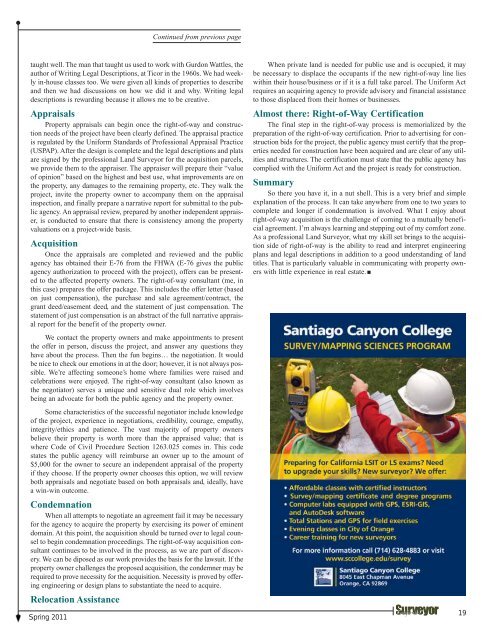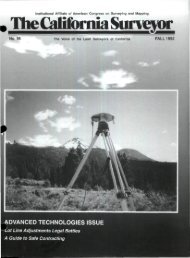Sacramento Surveyors Visit the NGS Airborne Gravimeter - CLSA
Sacramento Surveyors Visit the NGS Airborne Gravimeter - CLSA
Sacramento Surveyors Visit the NGS Airborne Gravimeter - CLSA
Create successful ePaper yourself
Turn your PDF publications into a flip-book with our unique Google optimized e-Paper software.
Continued from previous page<br />
taught well. The man that taught us used to work with Gurdon Wattles, <strong>the</strong><br />
author of Writing Legal Descriptions, at Ticor in <strong>the</strong> 1960s. We had weekly<br />
in-house classes too. We were given all kinds of properties to describe<br />
and <strong>the</strong>n we had discussions on how we did it and why. Writing legal<br />
descriptions is rewarding because it allows me to be creative.<br />
Appraisals<br />
Property appraisals can begin once <strong>the</strong> right-of-way and construction<br />
needs of <strong>the</strong> project have been clearly defined. The appraisal practice<br />
is regulated by <strong>the</strong> Uniform Standards of Professional Appraisal Practice<br />
(USPAP). After <strong>the</strong> design is complete and <strong>the</strong> legal descriptions and plats<br />
are signed by <strong>the</strong> professional Land Surveyor for <strong>the</strong> acquisition parcels,<br />
we provide <strong>the</strong>m to <strong>the</strong> appraiser. The appraiser will prepare <strong>the</strong>ir “value<br />
of opinion” based on <strong>the</strong> highest and best use, what improvements are on<br />
<strong>the</strong> property, any damages to <strong>the</strong> remaining property, etc. They walk <strong>the</strong><br />
project, invite <strong>the</strong> property owner to accompany <strong>the</strong>m on <strong>the</strong> appraisal<br />
inspection, and finally prepare a narrative report for submittal to <strong>the</strong> public<br />
agency. An appraisal review, prepared by ano<strong>the</strong>r independent appraiser,<br />
is conducted to ensure that <strong>the</strong>re is consistency among <strong>the</strong> property<br />
valuations on a project-wide basis.<br />
Acquisition<br />
Once <strong>the</strong> appraisals are completed and reviewed and <strong>the</strong> public<br />
agency has obtained <strong>the</strong>ir E-76 from <strong>the</strong> FHWA (E-76 gives <strong>the</strong> public<br />
agency authorization to proceed with <strong>the</strong> project), offers can be presented<br />
to <strong>the</strong> affected property owners. The right-of-way consultant (me, in<br />
this case) prepares <strong>the</strong> offer package. This includes <strong>the</strong> offer letter (based<br />
on just compensation), <strong>the</strong> purchase and sale agreement/contract, <strong>the</strong><br />
grant deed/easement deed, and <strong>the</strong> statement of just compensation. The<br />
statement of just compensation is an abstract of <strong>the</strong> full narrative appraisal<br />
report for <strong>the</strong> benefit of <strong>the</strong> property owner.<br />
We contact <strong>the</strong> property owners and make appointments to present<br />
<strong>the</strong> offer in person, discuss <strong>the</strong> project, and answer any questions <strong>the</strong>y<br />
have about <strong>the</strong> process. Then <strong>the</strong> fun begins… <strong>the</strong> negotiation. It would<br />
be nice to check our emotions in at <strong>the</strong> door; however, it is not always possible.<br />
We’re affecting someone’s home where families were raised and<br />
celebrations were enjoyed. The right-of-way consultant (also known as<br />
<strong>the</strong> negotiator) serves a unique and sensitive dual role which involves<br />
being an advocate for both <strong>the</strong> public agency and <strong>the</strong> property owner.<br />
Some characteristics of <strong>the</strong> successful negotiator include knowledge<br />
of <strong>the</strong> project, experience in negotiations, credibility, courage, empathy,<br />
integrity/ethics and patience. The vast majority of property owners<br />
believe <strong>the</strong>ir property is worth more than <strong>the</strong> appraised value; that is<br />
where Code of Civil Procedure Section 1263.025 comes in. This code<br />
states <strong>the</strong> public agency will reimburse an owner up to <strong>the</strong> amount of<br />
$5,000 for <strong>the</strong> owner to secure an independent appraisal of <strong>the</strong> property<br />
if <strong>the</strong>y choose. If <strong>the</strong> property owner chooses this option, we will review<br />
both appraisals and negotiate based on both appraisals and, ideally, have<br />
a win-win outcome.<br />
Condemnation<br />
When all attempts to negotiate an agreement fail it may be necessary<br />
for <strong>the</strong> agency to acquire <strong>the</strong> property by exercising its power of eminent<br />
domain. At this point, <strong>the</strong> acquisition should be turned over to legal counsel<br />
to begin condemnation proceedings. The right-of-way acquisition consultant<br />
continues to be involved in <strong>the</strong> process, as we are part of discovery.<br />
We can be diposed as our work provides <strong>the</strong> basis for <strong>the</strong> lawsuit. If <strong>the</strong><br />
property owner challenges <strong>the</strong> proposed acquisition, <strong>the</strong> condemner may be<br />
required to prove necessity for <strong>the</strong> acquisition. Necessity is proved by offering<br />
engineering or design plans to substantiate <strong>the</strong> need to acquire.<br />
Relocation Assistance<br />
Spring 2011<br />
When private land is needed for public use and is occupied, it may<br />
be necessary to displace <strong>the</strong> occupants if <strong>the</strong> new right-of-way line lies<br />
within <strong>the</strong>ir house/business or if it is a full take parcel. The Uniform Act<br />
requires an acquiring agency to provide advisory and financial assistance<br />
to those displaced from <strong>the</strong>ir homes or businesses.<br />
Almost <strong>the</strong>re: Right-of-Way Certification<br />
The final step in <strong>the</strong> right-of-way process is memorialized by <strong>the</strong><br />
preparation of <strong>the</strong> right-of-way certification. Prior to advertising for construction<br />
bids for <strong>the</strong> project, <strong>the</strong> public agency must certify that <strong>the</strong> properties<br />
needed for construction have been acquired and are clear of any utilities<br />
and structures. The certification must state that <strong>the</strong> public agency has<br />
complied with <strong>the</strong> Uniform Act and <strong>the</strong> project is ready for construction.<br />
Summary<br />
So <strong>the</strong>re you have it, in a nut shell. This is a very brief and simple<br />
explanation of <strong>the</strong> process. It can take anywhere from one to two years to<br />
complete and longer if condemnation is involved. What I enjoy about<br />
right-of-way acquisition is <strong>the</strong> challenge of coming to a mutually beneficial<br />
agreement. I’m always learning and stepping out of my comfort zone.<br />
As a professional Land Surveyor, what my skill set brings to <strong>the</strong> acquisition<br />
side of right-of-way is <strong>the</strong> ability to read and interpret engineering<br />
plans and legal descriptions in addition to a good understanding of land<br />
titles. That is particularly valuable in communicating with property owners<br />
with little experience in real estate.<br />
19
















